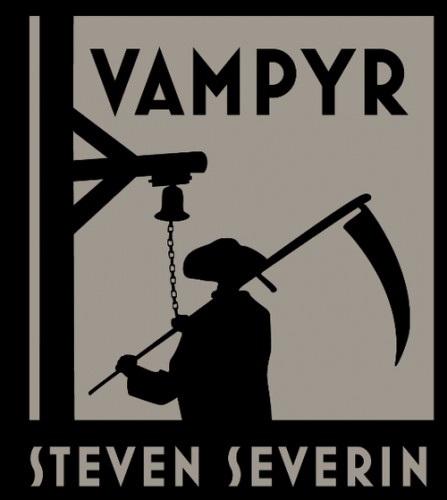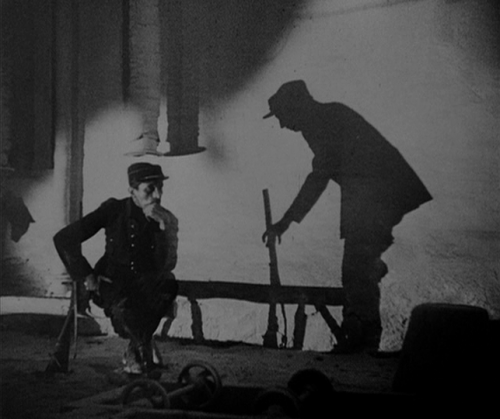
Ian Olson (who brought Mbird a wonderful reflection on Law and Grace in the new Godzilla) and I decided to put together a 4-part series in celebration of October and Halloween–Mbird-style, of course! We both chose two of our favorite horror films and wrote an article for each one and then allowed the other to present a brief addendum/rebuttal about the film and the article written. This week we open with a classic vampire film from 1932 from the Danish filmmaker, Carl Theodor Dreyer, entitled Vampyr.
 Ian:
Ian:
How awake must I be to grasp the real world? To see it for what it really is and navigate its complexities? We in the West take it for granted that to be awake is to see and to see is to hook onto reality in its fullness. But what if my waking vision actually obscures a vital layer of the real? What if there’s something else right here, dwelling at right angles to the visible and evading my limited senses and clumsy cognition? Carl Theodor Dreyer’s 1932 film Vampyr presupposes such a reality coexistent with our own, pushing and pulling against the grain of the ordinary; a reality in which death permeates every cubic centimeter, warping light into darkness and suffocating every vestige of hope, a reality as porous as dream and as terrifying.
Vampyr is the residue of the most unsettling nightmare you’ve ever awoken from captured on celluloid. In it, Dreyer pierces the fog surrounding the waking world and renders partially visible the spiritual machinations percolating under what we presume to be the “real”: the linear, unremarkable system of cause and effect we daily encounter, governed by rational laws which preclude supernatural agents of any sort. Why is it, then, that we sometimes sense inexplicable things seeping through the tidy closed loop we’ve circumscribed? We intuit other factors, often unseen, disrupting the economy of the normal and preconceived, contributing to outcomes we couldn’t foresee. We tend to marginalize these unknowns and relegate them to the sphere of make-believe, for our own sanity’s sake. But what if the status quo is merely one layer of the world-in-itself? Our active dismissal and erasure of feedback from this realm would likely leave our nightmares as the only point of contact between us and it.
Vampyr’s dream logic calls our everyday interpretation of the world into question by defying the conventions of rationality we take for granted as real. In the world of Vampyr, shadows roam without subjects to cast them; doors open to flood rooms with darkness; cause and effect break down into inexplicable appearances and actions without apparent motive. The film’s protagonist, Allan Gray, whose immersion into occult studies has plunged him into a permanent twilight of half-awake terrors, finds himself swept into this world. Allan’s face is frozen in wide-eyed astonishment; he appears perpetually stunned, as if he’s never sure he’s awake or asleep. The film’s prologue seems to suggest that his grip on reality is slipping, but as the plot unfolds it seems just as likely that this has equipped him to deal with the otherworldly forces besieging the town of Courtempierre. The village is held in thrall to the old vampiress Chopin, whose curse is an acid corroding the fabric of waking reality. Poisoned by Chopin, Courtempierre is a palimpsest of every pre-modern fear we’ve suppressed, a repository of every death symbol in our collective unconscious. Scythes, skulls, and shadows litter the village’s squalid buildings, whose architecture is imbued with an eerie spatial incoherence via Dreyer’s skillful direction.
 Dreyer craftily exploits the logic of dream throughout the film. The soft focus cinematography visualizes the blurring of reality and dream, and Dreyer’s insistence upon filming with a layer of gauze over the lens casts an hallucinatory fog about everything. This filter effects a phantasmagoric mediacy which keeps us at a remove from everything we see, mirroring the shadows wandering Courtempierre. This triggers the uncomfortable question: Who’s haunting who? Dreyer’s cuts erase any continuity from angle to angle and room to room, leaving the viewer dislocated from any sense of a center, any sense of rational geometry or linear motion. Subjectivity suddenly elides into objectivity without warning as when Allan enters his own point-of-view pan around a room. Who is the observer in these sequences? Have we, too, been swept into the shadowland?
Dreyer craftily exploits the logic of dream throughout the film. The soft focus cinematography visualizes the blurring of reality and dream, and Dreyer’s insistence upon filming with a layer of gauze over the lens casts an hallucinatory fog about everything. This filter effects a phantasmagoric mediacy which keeps us at a remove from everything we see, mirroring the shadows wandering Courtempierre. This triggers the uncomfortable question: Who’s haunting who? Dreyer’s cuts erase any continuity from angle to angle and room to room, leaving the viewer dislocated from any sense of a center, any sense of rational geometry or linear motion. Subjectivity suddenly elides into objectivity without warning as when Allan enters his own point-of-view pan around a room. Who is the observer in these sequences? Have we, too, been swept into the shadowland?
In and through such motifs, Vampyr‘s plot and atmosphere typify waking vision as “seeing through a glass darkly” (literally, at times- some of the film’s key moments are witnessed by Allan through hazy windows). Dreams grasp the associations tethering the empirical to the mystical, the seen to the unseen, functioning as a tertium quid, mediating the way between the subject-less shadows and the physical reality they manipulate. Vampyr questions the metaphysics of action and matter with its poetics of shadow; in this world, absence is a positive presence of its own. The absence of light and life casts its own dark reflection upon the world of the visible, influencing it from a distance which is, horrifyingly, no distance at all. This proximity is only disclosed and understood through dreams.
Take what is undoubtedly the film’s most chilling sequence. Unwittingly retracing his first steps into Courtempierre, Allan happens upon a corpse in the same casket he glimpsed earlier: his own. In a long, first person funeral procession, we see Chopin and her minions peering into the casket’s window from Allan’s dead perspective. Now we see: crossing over into Courtempierre was a crossing over into death. And though he returns to his body and defeats Chopin, is there any guarantee he has really eluded death? What was the nature of his arrival in the first place? Did he voyage into the far country to take on its living death and rescue it? Or is he in Courtempierre because that is precisely where he belongs?
The cumulative effect of all these devices, when wed to such an elusive narrative, is greater than the sum of their parts. So successful is it, in fact, that it comes close to subverting its own literal sense. Has Allan been dreaming the entire thing? This ambiguity is one of the most unsettling aspects of the film: how much of this actually transpired in our world? How safe are we from these powers lurking at the margins? And if it was all a dream, is that good news? Should we allow that to reinforce our narrative of safety? Furthermore, does Allan ever wake up, or is he doomed to roam that shadowy borderland between dying and sleeping? Dreyer guards his secrets well, so we can’t be sure. If it’s the latter, then Allan’s spiral back to the beginning of the film in his final dream suggests this too will recommence once night has fallen; perhaps once more, but then again… perhaps forever?
 Dreyer wants us to question the validity of our surface impressions and continue exploring beyond the immediately sensible, in our primary world and in the world of the film. And the subsequent need to rewatch and re-rewatch Vampyr means we are forced into the closed loop of Allan’s nightmare alongside him as one of the spectral shades haunting Courtempierre.
Dreyer wants us to question the validity of our surface impressions and continue exploring beyond the immediately sensible, in our primary world and in the world of the film. And the subsequent need to rewatch and re-rewatch Vampyr means we are forced into the closed loop of Allan’s nightmare alongside him as one of the spectral shades haunting Courtempierre.
Blake:
At a website dedicated to the life and work of Carl Dreyer, one can read a brief biography of the man’s life and the films he directed. I found that Dreyer’s own words echo exactly the same notes as Ian’s piece above: “in Vampyr I wanted to create daydreams on film and show that the uncanny does not lie in the things around us but in our own subconscious minds.” Now, his wording could be taken to be more in the vein of Freud or Jung with the hat tip to the playground of the subconscious, but he nonetheless rejects the empiricism of those who choose to live their lives, to paraphrase Madonna, as material people, living in a material world.
The beauty of Dreyer’s film is that it has a more holistic conception of what is contained in “reality.” To discount dreams/nightmares, spiritual experiences, etc. is to cut off a large portion of human experience and life simply because they are not objectively empirical in nature. Dreyer portrays a world where the full experience of humanity is connected and not only informs (and forms) reality but is essential to who we are as people. To ascertain a person solely by their material nature is to objectify and debase that person to the point where action and output becomes the only measure of their humanity. Alas, we all know what happens when performance and substance become too closely yoked.
You can watch the whole film below:
[youtube=https://www.youtube.com/watch?v=aUZihZPiyGU&w=600]

COMMENTS
7 responses to ““Is This Real Life or Is This Just Fantasy”: Carl Dreyer’s Vampyr (1932)”
Leave a Reply













Carl Dreyer directed the very best “Christian Film” ever – Ordet. It’s a cinematized version of an old Danish play and it is utterly amazing from start to finish. The lighting, the cinematography, the acting, the characters, the multi-layered plot, and the final scene where the protagonist delivers a powerful indictment of cold, Christless religion. Awesome film, awesome director. Glad someone else recognizes his genius!
JT, thanks for the comment!
I have been needing to dig into more of Dreyer’s work because I believe this is the only film I have seen of his. I don’t know if Ian has seen any of his other films, including Ordet, but I would imagine that his other work would need to be put higher on both of our queues!
I second that. I’ve never seen a film like Ordet, ever.
Blake, get that movie! It’s a must-see! Far exceeds (and this is an understatement) the current mainstream brand of “Christian films” with which our American pop culture is familiar. Also, Dreyer’s films Joan of Arc (silent film made up almost entirely of close up facial shots) AND Gertrud are classics as well. Also, Day of Wrath is a good Dreyer film. Gertrud though I think is considered one of his finest pieces.
The Passion of Joan of Arc is phenomenal- very haunting, and very interesting to discern how one vision unites both. I have to immerse myself in the rest of his ouevre, though, but I hope to soon!